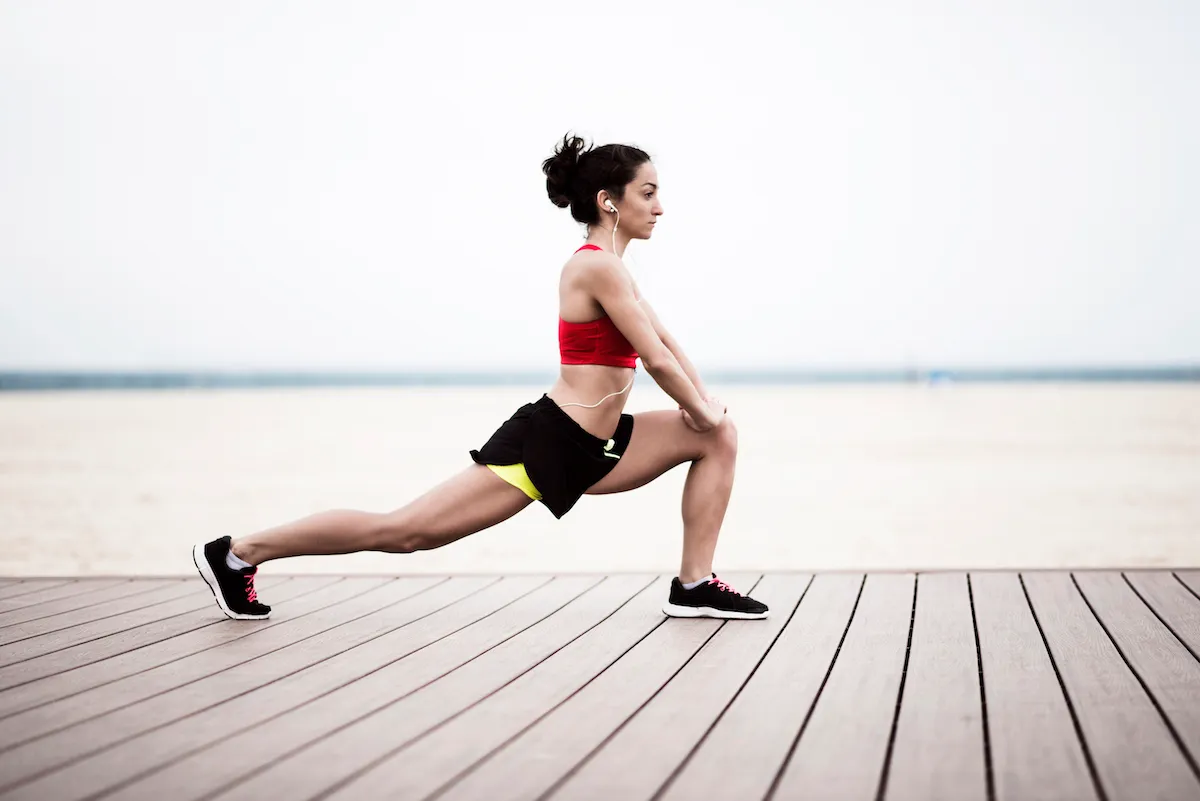Due to the demands of the sport, hip pain is a common occurrence in triathletes, particularly hip pain when running.
It can be difficult to correctly diagnose and treat, as pain can come from structures within the hip joint itself, or from structures surrounding the hip joint.
It may be felt in front of the hip as groin pain, on the outside of the hip, or at the back in the buttock.
The hip is the largest ball-and-socket joint in the body, connecting the thigh bone (femoral head) snugly into a cup-shaped socket (acetabulum) in the pelvis. It bears our body’s weight (up to six times in running) and the force of the muscles of the hip and leg.
In addition the hip joint is also one of our most flexible joints and allows a large range of movement.
Muscles, tendons and ligaments all support the hip, as well as several fluid-filled sacks or bursea. In short, there’s a lot to go wrong!
Most hip issues are simple and involve overuse or tendonopathies of the muscles that attach into the hip such as the hip flexors and hamstrings.
Illio tibial band and piriformis syndrome are also common in running sports and need to be ruled out by assessment from a physiotherapist.
If these common ailments have been ruled out, then a number of deeper structures may be responsible for your pain.
Here we’ll look at three such injuries and the common signs and symptoms associated with them.
3 potential causes of hip pain when running
Labral tears
What is it?
The labrum is a band of cartilage surrounding the hip, providing additional stability of the joint.
The labrum can be torn or injured as a result of trauma, such as a fall or bike crash, but is most commonly caused by repetitive trauma to the hip joint.
Running with poor biomechanics or with ineffective muscle balance and function around the hip can be responsible. A labral tear results when a part of the labrum separates or is pulled away from the socket.
What causes it?
Hip labral tears may result from a combination of several different variables, including: bony abnormalities in the hip joint (hip impingement); hip muscle tightness; hip muscle weakness; poor technique or biomechanics with repetitive activities; and high volumes of running.
The signs and symptoms include...
A deep ache in the front of your hip or groin; painful clicking or ‘catching’ with hip movements; increased pain with prolonged sitting; a sharp pain in the hip with end-range hip flexion.
Stress fractures
What is it?
During running the hip joint has to absorb a lot of load. Repeated load and overuse can result in a stress fracture of the hip, most commonly the neck of the femur.
A stress fracture is a small break in the bone in an area that is repetitively put under stress where the bone can’t recover.
What causes it?
Sudden increases in training load and volume; training when fatigued; poor run mechanics causing overload; unsuitable footwear; nutritional factors; low vitamin D levels; poor lower limb muscular conditioning.
Trochanteric hip bursitis
What is it?
Bursas are small sacks of fluid, found between bones and soft tissues, particularly tendons. They protect the soft tissue from rubbing against the underlying bone, reducing friction.
If the overlying tissues are too tight or biomechanically ineffective the bursa itself can sometimes become inflamed and irritated.
There are lots of bursas around the hip joint, but the most commonly injured is the trochanteric bursa. It sits on the outside of the hip, over a bony protrusion of the femur (the greater trochanter), and separates the bone from the ilio tibial band.
What causes it?
Overuse/repeated friction; large increases in run volume; muscle tightness (ITB); faulty lower limb biomechanics; weak glutes, causing overload through the hips; direct trauma to the area.
The signs and symptoms include..
Pain on the outside of the hip; pain worse after running; pain radiating down the side of the thigh; pain lying on the injured side; pain on palpation directly over the site of the bursea; swelling over the lateral side of the hip.
So as you can see, the hip is a complicated joint. It’s important to see a doctor or physiotherapist to get any issue correctly diagnosed, so that any investigations and treatment are effective.
5 exercises to keep your hip healthy

To keep your hip healthy and injury free, there are lots of preventative measures you can take: stretching and using the foam roller on muscles we know get commonly tight and overworked, as well as strengthening the glutes and posterior muscles that help to stabilise the pelvis and take excessive load off the hip.
Here are the exercises:
Hamstring stretch
Benefit
Helps with good hip positioning and reduces any alteration in biomechanics when running.
Method
Lie on your back, with your spine in a neutral position. Hold the leg to be stretched behind the knee. Slowly straighten the leg until you feel a stretch in the back of the leg (if this is painful, then the hamstring may need a longer period of relative rest).
Keep the back still in the initial start position. Hold for up to 30secs, until you start to feel the stretch ease off and repeat. You can use the other leg as a comparison, or take a picture to see progression. Repeat 4-6 times.
Clam
Benefit
A clam works the deeper muscles of the glute that help to stabilise the pelvis and reduce hip-drop during running.
Method
With the heels together, raise the knee to work the glute. The pelvis should stay still throughout, with no rotation.
There are many ways to progress the exercise with the leg in different positions, as well as adding the resistance of a band. Try to progress to 3 sets of 30.
ITB foam roller
Benefit
Soft tissue release and trigger point work on the ITB helps to maintain good hip biomechanics.
Method
Lie on your right side with the roller just under your hip bone. Straighten your right leg, support yourself using your arms and if needed the left leg. Roll from the hip down the outer side of your leg to the knee. Repeat on the other side.
Lateral side step with band
Benefit
Strengthens the musculature around the outside of the hip, which prevents the knee dropping inwards on foot plant when running.
Method
Pop a piece of band around your ankles. Start in a semi squat position with slight tension on the band. Step the foot out sideways, so you’re pushing against the band.
Keep your body facing forwards and shoulders level. Ten steps then repeat in the other direction.
Hip flexor
Benefit
As with the hamstring above.
Method
In a forward lunge position, keep the pelvis facing forwards, and your chest up straight. You will be stretching the leg behind you.
Slowly transfer your weight forwards, pushing the hip to be stretched forwards too. Hold for 5 x 30secs.
You can increase the stretch by taking the arm up above your head on the side that you’re stretching.
Hip stretching tips

Stretching is part of your everyday routine as an athlete, but if you were to stretch every muscle that got worked in triathlon you’d be there for hours!
Here are my top tips to make sure you get the best out of your stretching programme…
Make it specific: If you know you always get tight in a specific muscle group, target that and the muscles around it.
30secs: There’s lots of research on timing of stretching. Over 30secs ensures that the muscle fibres are allowed to stretch and unwind.
Injury-specific: After an injury has healed and you’re back training, don’t stop doing the stretches or exercises you were advised to do (this is when many people tend to get re injured).
Pre- and post-training: Most people stretch after training, but it’s just as important to stretch before to get your muscles in the optimum position to work.
S&C: Make sure you have a conditioning programme to complement your stretches.
Top image credit: Getty Images
Related:
